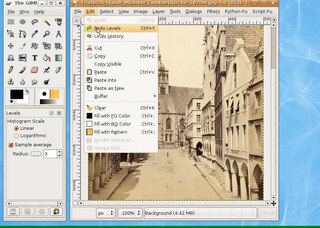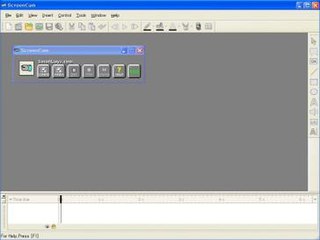
Microsoft PowerPoint is a presentation program, created by Robert Gaskins and Dennis Austin at a software company named Forethought, Inc. It was released on April 20, 1987, initially for Macintosh computers only. Microsoft acquired PowerPoint for about $14 million three months after it appeared. This was Microsoft's first significant acquisition, and Microsoft set up a new business unit for PowerPoint in Silicon Valley where Forethought had been located.
Hypermedia, an extension of the term hypertext, is a nonlinear medium of information that includes graphics, audio, video, plain text and hyperlinks. This designation contrasts with the broader term multimedia, which may include non-interactive linear presentations as well as hypermedia. It is also related to the field of electronic literature. The term was first used in a 1965 article written by Ted Nelson.

Problem-based learning (PBL) is a student-centered pedagogy in which students learn about a subject through the experience of solving an open-ended problem found in trigger material. The PBL process does not focus on problem solving with a defined solution, but it allows for the development of other desirable skills and attributes. This includes knowledge acquisition, enhanced group collaboration and communication.

Web conferencing is used as an umbrella term for various types of online conferencing and collaborative services including webinars, webcasts, and web meetings. Sometimes it may be used also in the more narrow sense of the peer-level web meeting context, in an attempt to disambiguate it from the other types known as collaborative sessions. The terminology related to these technologies is exact and agreed relying on the standards for web conferencing but specific organizations practices in usage exist to provide also term usage reference.

A screencast is a digital recording of computer screen output, also known as a video screen capture or a screen recording, often containing audio narration. The term screencast compares with the related term screenshot; whereas screenshot generates a single picture of a computer screen, a screencast is essentially a movie of the changes over time that a user sees on a computer screen, that can be enhanced with audio narration and captions.
A learning management system (LMS) is a software application for the administration, documentation, tracking, reporting, automation, and delivery of educational courses, training programs, materials or learning and development programs. The learning management system concept emerged directly from e-Learning. Learning management systems make up the largest segment of the learning system market. The first introduction of the LMS was in the late 1990s. Learning management systems have faced a massive growth in usage due to the emphasis on remote learning during the COVID-19 pandemic.
Educational technology is the combined use of computer hardware, software, and educational theory and practice to facilitate learning. When referred to with its abbreviation, edtech, it often refers to the industry of companies that create educational technology.

Adobe Captivate is an authoring tool that is used for creating eLearning content such as software demonstrations, software simulations, branched scenarios, and randomized quizzes in Shockwave Flash and HTML5 formats.
Audience response is a type of interaction associated with the use of audience response systems, to create interactivity between a presenter and its audience.
Accordent Technologies was a company that produces software for streaming media creation and management. Its headquarters are located in El Segundo, California and has sales and development offices in Seattle, London, New York City, Atlanta, Dallas and Austin.

ScreenCam is a screencast tool for Microsoft Windows that is used to author software demonstrations, software simulations, branched scenarios, and tutorials in .swf format. ScreenCam was primarily targeted at users who need to create video-oriented instructional materials who were not multimedia authors or video capture technicians. It was very easy to use, having a 'VCR-like' interface and requiring no knowledge of digital video editing, or the concept of 'frames' of a movie, because it used a different paradigm for creating the screen movies. It can also be used for creation of screencasts and conversion of Microsoft PowerPoint presentations to the Adobe Flash format.
Camtasia is a software suite, created and published by TechSmith, for creating and recording video tutorials and presentations via screencast, or via a direct recording plug-in to Microsoft PowerPoint. Other multimedia recordings may be recorded at the same time or added separately. Camtasia is available in English, French, German, Japanese, Portuguese, Spanish and Chinese versions.

A screenshot is a digital image that shows the contents of a computer display. A screenshot is created by the operating system or software running on the device powering the display.

ScreenCorder is a desktop recording tool for Microsoft Windows Operating Systems, developed and distributed by MatchWare. The program allows the user to record everything that happens on their desktop as viewed on their monitor, edit the recording and then export it to a redistributable video format. Uses include the creation of training videos, product support videos, sales presentations, and demonstration videos. Recorded content can be enhanced with audio instructions, graphic speech bubbles, magnifications, animations, and multimedia content.
Rapid learning has traditionally referred to a methodology to build e-learning courses rapidly. Typically the author will create slides in PowerPoint, record audio and video narration on top of the slides, and then use software to add tests, or even collaboration activities between the slides. The whole package is then sent, most often as an Adobe Flash file, to a learning management system or website.

ActivePresenter is all-in-one screencasting, video editing, and eLearning authoring software for Microsoft Windows and macOS, which is developed by Atomi Systems, Inc.
A virtual learning environment (VLE) in educational technology is a web-based platform for the digital aspects of courses of study, usually within educational institutions. They present resources, activities, and interactions within a course structure and provide for the different stages of assessment. VLEs also usually report on participation and have some level of integration with other institutional systems. In North America, VLE's are often referred to as Learning Management Systems (LMS).
iSpring Suite is a PowerPoint-based authoring toolkit produced by iSpring Solutions that allows users to create slide-based courses, quizzes, dialog simulations, screencasts, video lectures, and other interactive learning materials. The output courses are published in HTML5. iSpring-made courses are compatible with the following LMS standards:SCORM 1.2, SCORM 2004, AICC, xAPI, and cmi5.

Adobe Presenter is eLearning software released by Adobe Systems available on the Microsoft Windows platform as a Microsoft PowerPoint plug-in, and on both Windows and OS X as the screencasting and video editing tool Adobe Presenter Video Express. It is mainly targeted towards learning professionals and trainers. In addition to recording one's computer desktop and speech, it also provides the option to add quizzes and track performance by integrating with learning management systems. Adobe Presenter was designed to replace the now discontinued Adobe Ovation software, which had similar functions.

Adobe Presenter Video Express is screencasting and video editing software developed by Adobe Systems.









